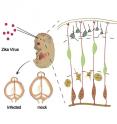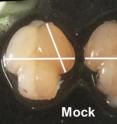Fetal mice with Zika infection get microcephaly
Related images
(click to enlarge)
Mouse fetuses injected with the Asian Zika virus strain and carried to term within their pregnant mothers display the characteristic features of microcephaly, researchers in China report May 11 in Cell Stem Cell. As expected, the virus infected the neural progenitor cells, and infected brains reveal expression of genes related to viral entry, altered immune response, and cell death. The authors say this is direct evidence that Zika infection causes microcephaly in a mammalian animal model. The research was a collaborative effort between Zhiheng Xu at the Institute of Genetics and Developmental Biology of the Chinese Academy of Sciences and Cheng-Feng Qin at the Beijing Institute of Microbiology and Epidemiology.
"The most surprising part of this study is that it was mostly neural progenitor cells that got infected in the beginning and mostly neurons that became infected at a later stage--5 days after injection when the presence of Zika virus increases several hundred folds." says co-senior author Xu. "However, almost all cell death was found in neurons other than neural progenitor cells. This indicates that neurons, but not neural progenitor cells, are prone to induced cell death by the Zika virus."
Zika virus was injected directly into fetal mouse brains. If given too early, the embryos didn't survive, so the researchers began by looking at the equivalent of the second trimester in humans, when the fetus's neural progenitor cells are intensively expanding and generating new neurons at the same time. With this model, they could observe as the brain shrunk with the increase in viral load combined with the intense immune response.
The mice survived to birth but were eaten by their mothers, which often occurs if pups are noticeably unwell, preventing further observation. To overcome this problem, the researchers plan to use lower doses of the Zika virus to see whether that will affect survival. The researchers are also working to identify potential drugs that could reverse the process of Zika-virus-induced microcephaly in mice.
"Mice are not humans, and we need be careful when translating our findings into human disease," says Qin, the other co-senior author on the paper. "Extensive experimental and clinical investigations are urgently needed in response to this global crisis."
"Our animal model, together with the global transcriptome datasets of infected brains, will provide valuable resources for further investigation of the underlying cellular and molecular mechanisms and management of Zika virus-related pathological effects during neural development," Xu says.
Source: Cell Press
Articles on the same topic
- Zika virus: Optimized tests for reliable diagnosisThu, 12 May 2016, 14:46:58 UTC
- Zika virus in Brazil kills brain cell, impairs intra uterine growth of mice fetusesWed, 11 May 2016, 19:37:08 UTC
- Mouse models show how Zika infects a fetus during pregnancyWed, 11 May 2016, 19:36:38 UTC
- Mouse models of Zika in pregnancy show how fetuses become infectedWed, 11 May 2016, 19:36:27 UTC
- Zika virus damages placenta, kills fetal miceWed, 11 May 2016, 19:36:15 UTC
Other sources
- Germany reports 1st sexual transmission of Zika virusfrom AP HealthFri, 13 May 2016, 15:01:16 UTC
- [In Depth] Animals show how Zika harms fetusesfrom Science NOWThu, 12 May 2016, 19:20:52 UTC
- Zika virus: Optimized tests for reliable diagnosisfrom Science DailyThu, 12 May 2016, 15:40:53 UTC
- Zika virus 'shrinks brains' in testsfrom BBC News: Science & NatureThu, 12 May 2016, 10:30:52 UTC
- Fetal mice with Zika infection get microcephalyfrom Biology News NetWed, 11 May 2016, 23:21:23 UTC
- Mouse models show how Zika infects a fetus during pregnancyfrom Biology News NetWed, 11 May 2016, 23:21:22 UTC
- Fetal mice with Zika infection get microcephalyfrom Science DailyWed, 11 May 2016, 19:30:56 UTC
- Mouse models of Zika in pregnancy show how fetuses become infectedfrom Science DailyWed, 11 May 2016, 19:30:55 UTC
- Zika virus kills brain cells impairs intra uterine growth of mice fetusesfrom Science DailyWed, 11 May 2016, 19:30:52 UTC
- How vacationer's Zika virus rash and spots could help doctors focus diagnosisfrom CBC: HealthWed, 11 May 2016, 16:30:52 UTC
- Zika test of urine could make infection easier to detectfrom CBC: HealthTue, 10 May 2016, 19:00:59 UTC
- Urine test could simplify Zika virus detectionfrom AP HealthTue, 10 May 2016, 18:01:06 UTC
- Pregnant Connecticut teen shocked to learn she has Zikafrom AP HealthMon, 9 May 2016, 19:31:02 UTC

